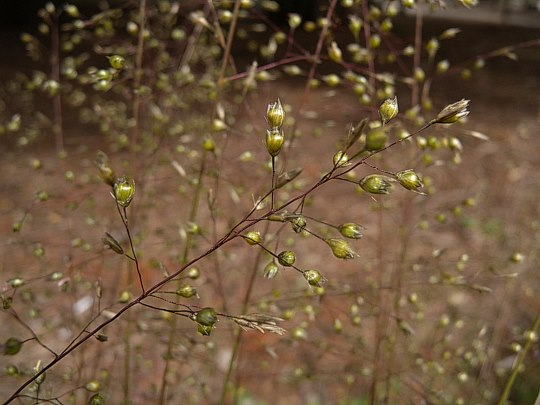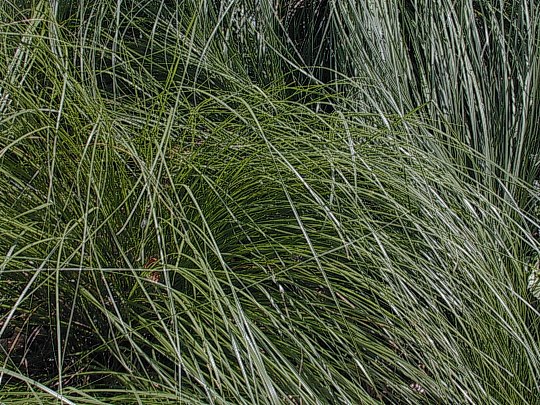Description: This perennial grass forms dense tufts of sprawling leaves about 1-2' tall and 2-3' across. In each tuft, the infertile (flowerless) shoots are more abundant than the fertile (flowering) shoots. One or more flowering culms develop from the center of each leafy clump; these culms are 1½–3' long and usually ascending to erect. Each culm is slender, terete, light green, and hairless. Alternate leaves are located along the lower one-fourth of each culm. The narrow leaf blades are up to 20" long and 2 mm. across; they are medium green, hairless, and either flat or somewhat rolled lengthwise. The leaf sheaths are usually hairless, although a few hairs may be present at their summits.

Each fertile culm
terminates in a narrowly pyramidal panicle about 3-8" long; because of
its naked branches and small spikelets, this panicle has a somewhat
airy appearance. The wiry lateral branches of the panicle are 1-3" long
and ascending; they subdivide into shorter branchlets that ultimately
terminate in individual spikelets. The central axis of the panicle,
lateral branches, and branchlets are light green to purple, slender,
and hairless. Depending on their stage of development, the spikelets
can be olive green, silvery gray, golden yellow, or light tan. Each
spikelet is about 4-6 mm. long, consisting of a pair of unequal-sized
glumes, a single lemma, a membranous palea, and a floret. One glume is
4-6 mm. long, while the other glume is 2-4 mm. long; the lemma and
palea are 3.5–5.5 mm. long. Each floret has 3 reddish anthers and a
pair of
stigmata that are short, white, and feathery. The florets are
wind-pollinated. At maturity, the florets are replaced by globoid
grains that are a little less than 2 mm. across; this often causes
their paleae to split into two parts. Disarticulation of the spikelets
is above the glumes; the grains soon fall to the ground. The root
system is fibrous and short-rhizomatous. This grass spreads primarily
by reseeding itself.
Cultivation:
The preference is full sun, mesic to dry conditions, and soil that is
loamy, rocky, or gravelly. Because the seeds are difficult to
germinate, it is easier to propagate this grass by dividing the dense
tufts of leaves. Once it becomes established at a suitable site,
Prairie Dropseed is long-lived.
Range & Habitat:
The native Prairie Dropseed is occasional in the northern half of
Illinois, while
in the southern half of the state it is uncommon. Habitats consist
primarily of hill prairies, gravel prairies, dolomite prairies, black
soil prairies, cemetery prairies, prairie remnants along railroads, and
limestone glades. Less often, Prairie Dropseed has been found in
savannas, thinly wooded rocky bluffs, and grassy fens. This grass is
found primarily in high quality natural areas. It is also cultivated as
an ornamental plant.
Faunal Associations:
Occasionally, the foliage is eaten by grasshoppers, including Mermiria
bivitatta (Two-Striped Slant-faced Grasshopper) and Syrbula
admirabilis (Handsome Grasshopper). Prairie Dropseed is the
obligate host of two uncommon leafhoppers: Aflexia rubranura
(Red-Tailed Leafhopper) and the recently described Memnonia
panzeri. The seeds are eaten by sparrows and other
granivorous songbirds from late summer into winter; these species
include the Field Sparrow, Savannah Sparrow, Tree Sparrow, and
Slate-Colored Junco. The foliage is readily eaten by bison, cattle, and
horses. Sometimes voles and other small rodents dig burrows within the
dense tufts of leaves and root mass of this prairie grass.
Photographic
Location:
The photographs were taken on the campus of the University Illinois and
near the Anita Purves Nature Center in Urbana, Illinois.

Comments: This is one of the true prairie grasses. Because of its dense tufts of sprawling narrow leaves, there is really nothing else that closely resembles it. While some Sporobolus spp. (Dropseeds) have narrow spike-like inflorescences that are often partially hidden by their sheaths, other species in this genus have long-exerted inflorescences that are airy and open. Prairie Dropseed is a good example of this latter group; it has longer spikelets than other species in this group.